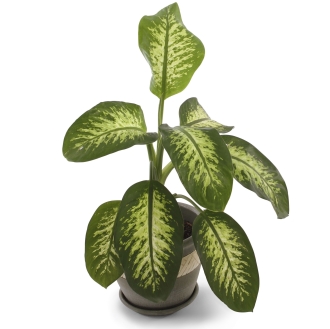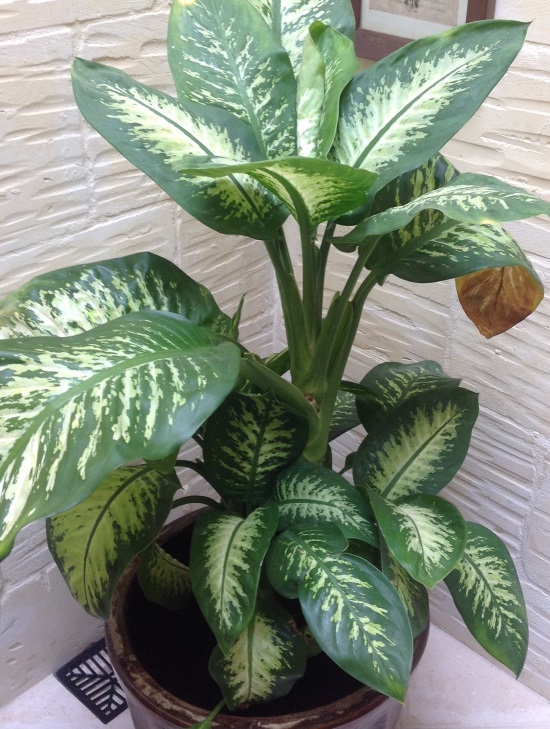
Dieffenbachia amoena is a very popular house plant due to its easy going nature. Plants that receive too little light or too little water will simply not grow as quickly as plants that are given proper care.
This native to the West Indies will flower in the right conditions, but these flowers are unimpressive. The beauty of the dumb cane plant comes from the unique pattern found on every leaf.
How it looks: Each plant features leaves which are yellow near their vein, abruptly turning a dark green toward the edge of the leaf. This transition is random, even within the same leaf, creating ribbons and spots of yellow and green along the leaf's body.
These leaves grow out of a central stem system. Each leaf will ultimately reach around 20 inches (47 cm) long, and 10 inches (25 cm) wide.
Flowering: Although this plant will occasionally produce buds that are 5 inches (12 cm) long, they will only bloom in perfect conditions. These blooms are green and rather unimpressive.
Most plant owners remove the buds when they appear, as they are a waste of the plant's energy. Always wash your hands thoroughly after removing buds, due to the sap's toxic nature.
Poisonous: This plant is poisonous, and should not be permitted near children or pets (cats & dogs). The sap of the plant is acrid, and, when ingested, will numb the throat and vocal cords, rendering the victim mute for up to two weeks until the poison wears off. The sap is highly irritating to the skin, and any interactions with the plant which result in sap exposure should be washed thoroughly.
Facts
Origin:
West Indies.
Names:
Dumb cane (common). -- Dieffenbachia Amoena (botanical/scientific).
Max Growth (approx):
Height 6ft.
Poisionous for pets:
Seriously toxic to cats and dogs.

Dumb Cane Care
Temperature:
Dieffenbachia amoena grows best when the temperature it is exposed to is between 65-75 ºF (18-23 ºC). Outside of this temperature zone, growth will continue at a greatly reduced rate, with tolerance extremes ranging from 40-90 ºF (4-35 ºC) Beyond these extremes, the plant will stop growing and may die with prolonged exposure.
Light:
This plant prefers bright, indirect sun light for the optimal growth. It will accept lighting conditions up to full shade and continue stunted growth. Full sun will burn the leaves.
Watering:
For the best results, keep the dumb cane plant's top inch of soil moist at all times. It will tolerate extended periods of watering neglect, but the leaves will begin to shrivel. Watering makes the leaves stiffen. Before moving the plant, allow the soil to dry out. This will give the leaves a more rubbery texture which will better survive the handling process.
Soil:
This plant is not picky about its soil conditions. It will grow in almost any soil mix except sand and orchid mixtures. For best results, a one to one mixture of potting soil and perlite should be used.
Fertilizer:
To encourage your plant to grow faster, you may introduce a full strength mixture of standard, balanced fertilizer once a month. Over-fertilization will cause the plant to start dropping leaves.
Re-Potting:
This plant needs to have its root density checked annually in the spring. If the roots are becoming dense, re-pot into a size bigger pot. Reduce watering for a week before transplant.
Humidity:
Normal room humidity is fine.
Propagation:
This plant propagates best from new growth cuttings or from breaking away young stems that grow on the side of the plant. Place these sideways in moist sand until roots begin to show, then transfer upright to soil.
Common Problem
This plant will only produce blooms from its buds if it is exposed to bright, indirect sunlight. Buds that turn brown on the ends should be removed from the plant immediately.







